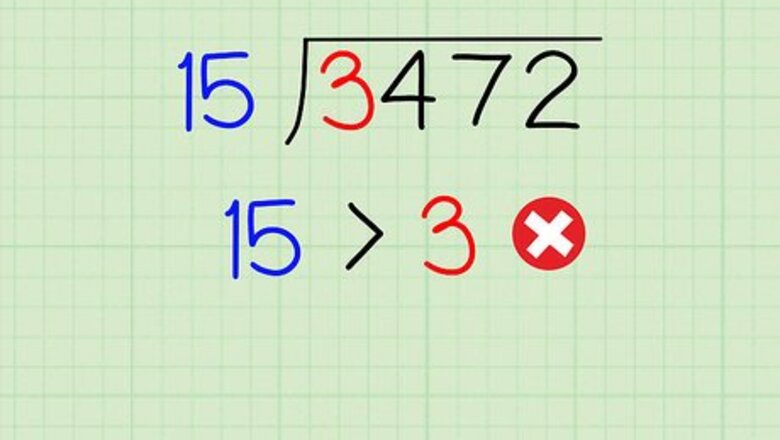
views
Dividing by a Two-Digit Number
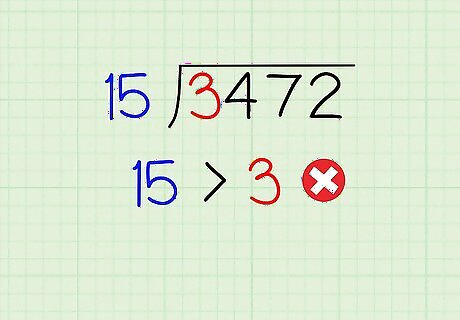
Look at the first digit of the larger number. Write the problem as a long-division problem. Just like a simpler division problem, you can start by looking at the smaller number, and asking "Does it fit into the first digit of the larger number?" Let's say you're solving 3472 ÷ 15. Ask "Does 15 fit into 3?" Since 15 is definitely larger than 3, the answer is "no," and we move on to the next step.
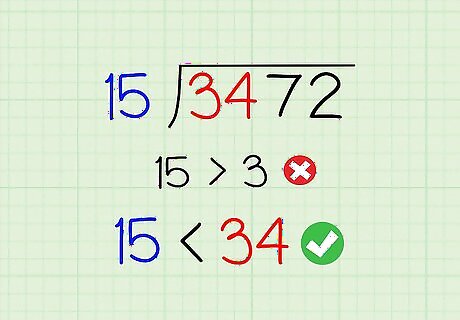
Look at the first two digits. Since you can't fit a two-digit number into a one-digit number, we'll look at the first two digits of the dividend instead, just like we would in a regular division problem. If you still have an impossible division problem, you'll need to look at the first three digits instead, but we don't need to in this example: Does 15 fit into 34? Yes, it does, so we can start calculating the answer. (The first number doesn't have to fit perfectly, it just needs to be smaller than the second number.)
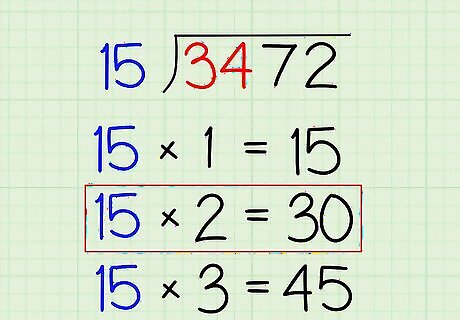
Use a little guesswork. Find out exactly how many times the first number fits into the other. You might know the answer already, but if you don't, try making a good guess and checking your answer with multiplication. We need to solve 34 ÷ 15, or "how many times does 15 go into 34"? You're looking for a number you can multiply with 15 to get a number less than 34, but pretty close to it: Does 1 work? 15 x 1 = 15, which is less than 34, but keep guessing. Does 2 work? 15 x 2 = 30. This is still less than 34, so 2 is a better answer than 1. Does 3 work? 15 x 3 = 45, which is greater than 34. Too high! The answer must be 2.

Write the answer above the last digit you used. If you set this up like a long division problem, this should feel familiar. Since you were calculating 34 ÷ 15, write the answer, 2, on the answer line above the "4."

Multiply your answer by the smaller number. This is the same as a normal long division problem, except we'll be using a two-digit number. Your answer was 2 and the smaller number in the problem is 15, so we calculate 2 x 15 = 30. Write "30" underneath the "34."

Subtract the two numbers. The last thing you wrote went underneath the original larger number (or part of it). Treat this as a subtraction problem and write the answer on a new line underneath. Solve 34 - 30 and write the answer underneath them on a new line. The answer is 4. This 4 is still "left over" after we fit 15 into 34 two times, so we'll need to use it in the next step.
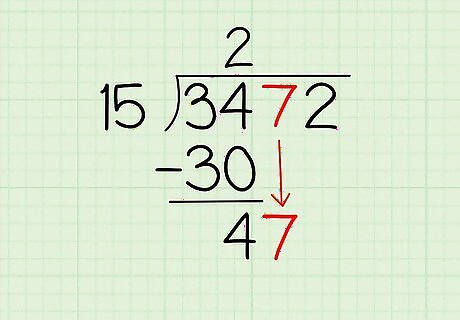
Bring down the next digit. Just like a regular division problem, we're going to keep calculating the next digit of the answer until we've finished. Leave the 4 where it is and bring down the "7" from "3472" to make 47.
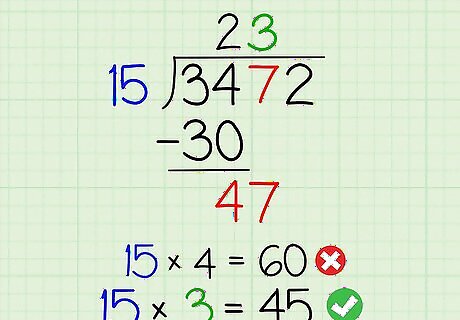
Solve the next division problem. To get the next digit, just repeat the same steps you did above for the new problem. You can use guesswork again to find the answer: We need to solve 47 ÷ 15: 47 is bigger than our last number, so the answer will be higher. Let's try four: 15 x 4 = 60. Nope, too high! We'll try three instead: 15 x 3 = 45. Smaller than 47 but close to it. Perfect. The answer is 3, so we'll write that about the "7" on the answer line. (If we ended up with a problem like 13 ÷ 15, with the first number smaller, we would need to bring down a third digit before we could solve it.)
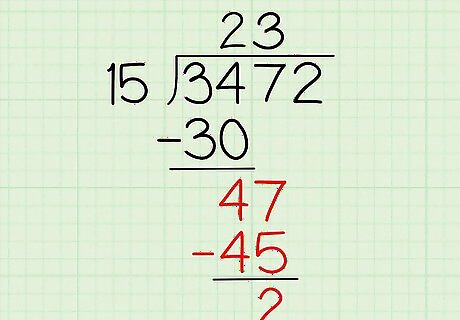
Continue using long division. Repeat the long division steps we used before to multiply our answer by the smaller number, write the result underneath the larger number, and subtract to find the next remainder. Remember, we just calculated 47 ÷ 15 = 3, and now we want to find what's left over: 3 x 15 = 45, so write "45" underneath the 47. Solve 47 - 45 = 2. Write "2" underneath the 45.
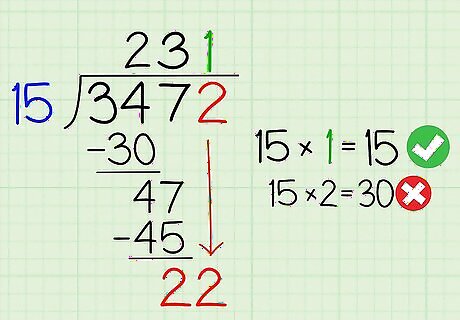
Find the last digit. As before, we bring down the next digit from the original problem so we can solve the next division problem. Repeat the steps above until you find every digit in the answer. We've got 2 ÷ 15 as our next problem, which doesn't make much sense. Bring down a digit to make 22 ÷ 15 instead. 15 goes into 22 one time, so we write "1" at the end of the answer line. Our answer is now 231.
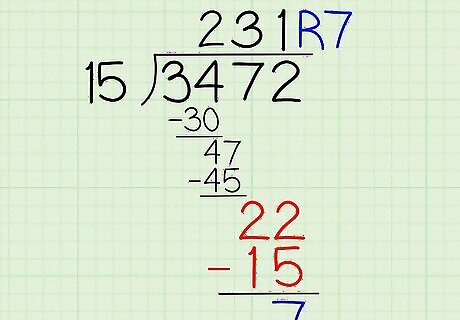
Find the remainder. One last subtraction problem to find the final remainder, then we'll be done. In fact, if the answer to the subtraction problem is 0, you don't even need to write a remainder at all. 1 x 15 = 15, so write 15 underneath the 22. Calculate 22 - 15 = 7. We have no more digits to bring down, so instead of more division we just write "remainder 7" or "R7" at the end of our answer. The final answer: 3472 ÷ 15 = 231 remainder 7
Making Good Guesses
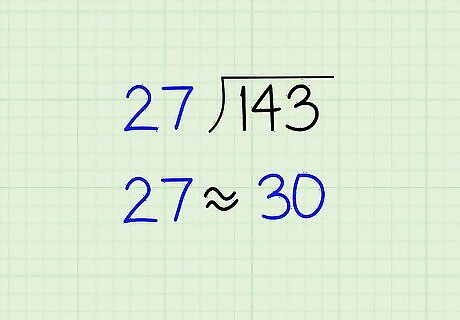
Round to the nearest ten. It's not always easy to see how many times a two-digit number goes into a larger one. One useful trick is to round to the nearest multiple of 10 to make guessing easier. This comes in handy for smaller division problems, or for parts of a long division problem. For example, let's say we're solving 143 ÷ 27, but we don't have a good guess at how many times 27 goes into 143. Let's pretend we're solving 143 ÷ 30 instead.
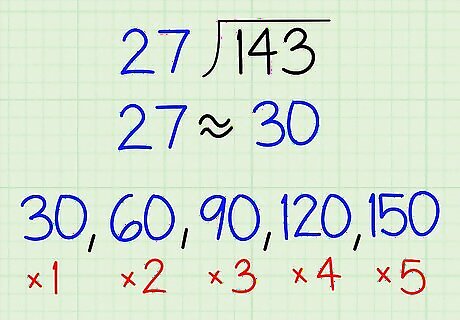
Count by the smaller number on your fingers. In our example, we can count by 30s instead of counting by 27s. Counting by 30 is pretty easy once you get the hang of it: 30, 60, 90, 120, 150. If you find this difficult, just count by threes and add a 0 to the end. Count until you get higher than the larger number in the problem (143), then stop.
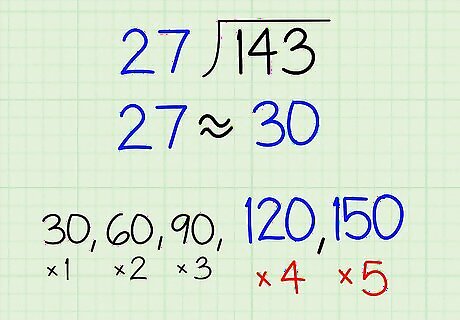
Find the two most likely answers. We didn't hit 143 exactly, but we got two numbers close to it: 120 and 150. Let's see how many fingers we counted on to get them: 30 (one finger), 60 (two fingers), 90 (three fingers), 120 (four fingers). So 30 x four = 120. 150 (five fingers), so 30 x five = 150. 4 and 5 are the two most likely answers to our problem.
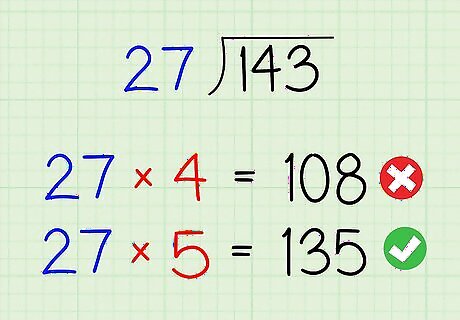
Test those two numbers with the real problem. Now that we have two good guesses, let's try them out on the original problem, which was 143 ÷ 27: 27 x 4 = 108 27 x 5 = 135
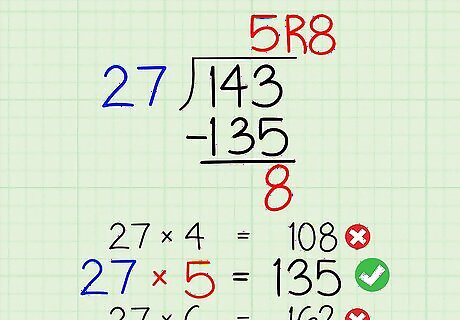
Make sure you can't get any closer. Since both our numbers ended up below 143, let's try getting even closer by trying one more multiplication problem: 27 x 6 = 162. This is higher than 143, so it can't be the right answer. 27 x 5 came closest without going over, so 143 ÷ 27 = 5 (plus a remainder of 8, since 143 - 135 = 8.)











Comments
0 comment